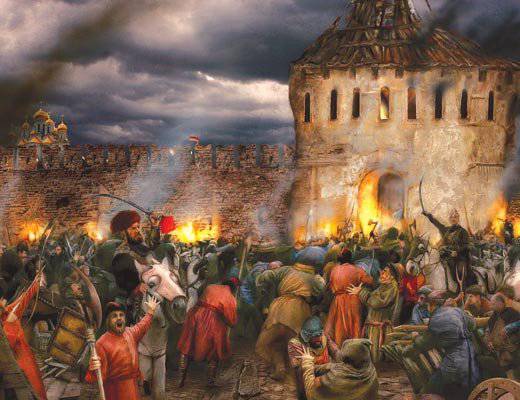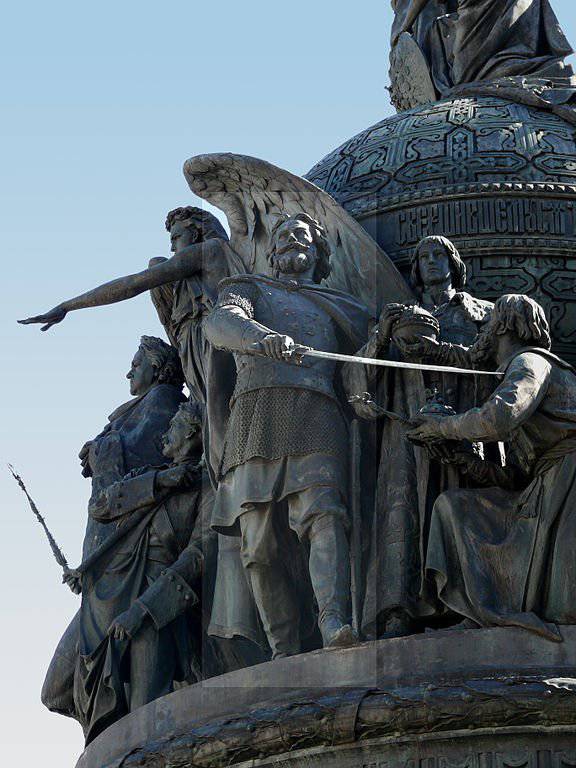Time of Troubles and the Cossacks. 3 part

The oath of the boyar government to prince Vladislav did not change the situation in a positive direction. Sweden received a pretext for a war with Russia and the annexation of a number of northern territories, since it was at war with Poland. The nobility, which was outraged on Russian territory, did not change its attitude towards Russian cities and villages, they considered them prey. Troops of Swedes, German and Hungarian mercenaries, Russian thieves roamed the territory of the Russian state.
One of the instigators of the people's struggle against the Troubles, his self-organization was the patriarch Hermogenes. Although he was kept in custody, messengers managed to sneak to him, among them were atamans Andrei Prosovetsky, Misha Cherkashin. The Patriarch said through such envoys that he was freeing the people of Russia from the oath to Vladislav and called for: “Man and arm yourself and mend the council among themselves, as if we are abundant from all enemies. The time has come! ”
The death of the second impostor. Create First Militia
In the fall of 1610, the False Dmitry and Kasimov's Khan, Uraz-Mohammed, had a conflict, an impostor suspected the Khan of betrayal. Khan was killed. Tatars in response in December 1610 killed the second impostor - he was hacked down during a walk outside Kaluga (they took advantage of the fact that only the Tatar guard and several people were with the “prince”), the head of the False Dmitry guard, baptized Tatar Peter Urus.
Marina Mnishek and his son "Tsarevich Ivan Dmitrievich" (he was nicknamed "Fouled"), under the auspices of Ataman Zarutsky, tried to play the same role - the Tsarina of Russia, but did not. Nobody took her seriously. The Kaluga camp was led by Zarutsky and Prince Dmitry Trubetskoy.
At this time, the gathering of the First National Militia begins in Ryazan for the liberation of Moscow. He headed Ryazan Voivode Prokopy Lyapunov. He was already noted during the Time of Troubles: he served with False Dmitry I and participated in the Bolotnikov uprising, but the actions of the Bolotnikovy people irritated the nobility, and Lyapunov went over to the side of Vasily Shuisky. He fought with detachments of the second impostor, defended the lands of Pereyaslavl-Ryazan, supported Moscow with food and reinforcements. After the strange death of Prince M.V. Skopin-Shuisky Lyapunov began to accuse Tsar Vasily Shuisky of poisoning his relative. He became a member of the removal of Vasily Shuisky from the throne. Initially, the voivode supported the idea of building the kingdom of Polish prince Vladislav, but after the death of False Dmitry II, the return of the Zemstvo representatives from Smolensk, who were part of the embassy, to the Poles, to receive appeals from Patriarch Hermogen Lyapunov changed his point of view.
The militia supported the majority of the detachments of the second impostor's troops, since they also did not recognize the power of the Poles over Russia. The army included the troops of Prince D.T. Trubetskoy, Masalsky, Pronsky, Mansurov, Nashchokin, Volkonsky, Volynsky, Izmaylov, Velyaminova, atamans of Zarutsky and Prosovetsky. Among the militias was a detachment of Zaraisk voevoda Prince Dmitry Pozharsky. Ryazan supported Nizhny Novgorod, and the majority of Volga and Siberian cities responded positively to the appeal of Nizhny Novgorod. Total gathered up 30 thousand fighters. In the spring of 1611, the militia moved to Moscow. The invaders were blocked in the city, in the absence of the tsar (the First Militia did not recognize Vladislav IV as the legitimate tsar) Lyapunov convened the Zemsky Sobor to elect the new tsar and headed the Russian government, thus becoming the ruler of Russia.
March 19 there was a fight between Muscovites and German mercenaries who served the Polish commandant. The interventionists considered that this uprising, and started the slaughter, several thousand citizens were killed. At the same time, the forward militias under the command of Pozharsky, Buturlin and Koltovsky entered Moscow. The slaughter turned into a fierce battle, as a result, the Poles realized that the advantage was not in their favor and that a hostile city could not be defended, they decided to burn it. The Poles themselves focused on the defense of China-city and the Kremlin, their stone walls were protected from fire. During the arson attacks, many churches and monasteries were plundered by the interventionists. During the massacre, battle and fire, according to various estimates, from 150 to 300 thousand people died, the capital was turned into ashes. Dmitry Pozharsky during the battle was seriously wounded and could no longer participate in the siege.
It was not possible to take Kitay-Gorod and the Kremlin; they were first-class fortresses, with powerful artillery and a professional garrison. The siege began. Sigismund III could not help the Polish garrison in Moscow, because Smolensk was connected. The Smolensk garrison heroically defended from 19 September 1609 of the year to 13 of June 1611 of the year, when the last defenders were killed by blowing up the Assumption Cathedral together with the advancing Poles. During this time, the Polish army lost up to 30 thousand people, was exhausted, drained of blood.
During the siege of Moscow revealed several controversial issues. First, the leaders - Lyapunov, Trubetskoy and Zarutsky - did not get along with each other. Ataman Zarutsky became the lover of Marina Mnishek and hatched plans to enthrone her son, Mnishek was to become regent, and he was the ruler. Secondly, there was an antagonism between the Cossacks and the nobles, the Cossacks did not want to obey discipline, give in to the nobles. Because of supply problems, they robbed the population, moreover, there was often just a rabble that floats during any Troubles. As a result, when several Cossacks were caught robbery, Lyapunov ordered to execute them without long trials. The Cossacks were outraged.
This was used by the Poles, they threw up forged Cossacks trumped-up letters, which said that Lyapunov allegedly plans to destroy the Cossacks, considering them to be "instigators of the turmoil." As a result, Lyapunov 22 June 1611, was summoned to the Cossack circle, and there, without becoming listen to his excuses, hacked to death.
The fall of Novgorod
After that, the majority of nobles increased their troops, with Zarutsky and Trubetskoy remaining insignificant forces. The difficult situation was in the north; in the spring of 1611 of the year, having replenished his army with fresh forces, the Swedish commander Delagardi (his clan was of French origin) invaded Novgorod and besieged the cities of Korela and Ladoga. In March, Delagardi approached Novgorod.
Governor I.I. Odoyevsky and Novgorod nobles decided to save themselves by committing treason. In secret from the common people, who were preparing for defense, the traitors entered into negotiations with the Swedish commander and concluded an agreement. According to him, one of the sons of the King of Sweden was invited to the Russian throne, and the administration of Novgorod was transferred to Delagardi together with Odoyevsky. It was agreed that if the Swede was not elected to the Russian throne, Novgorod should have declared him his grand duke and separated from Moscow. After that it was planned to create a special, independent Novgorod state.
Having entered into an agreement with the Novgorod nobility and the governor, the Swedes thought to seize the city without hindrance. Swedish troops crossed the Volkhov River and embarked at the Kolmov Monastery. 8 July 1611, the Swedes tried to enter the city, but could not, their attacks were repulsed. To fulfill the agreement, the Novgorod nobility on the night of July 16, 1611, was able to open the Chudintsev gates of the city to the Swedish army. In Novgorod, the massacre, panic, began, part of the population fiercely resisted. So, Ataman Timofey Sharov with 40 Cossacks rejected the offer to surrender, and the whole squad fell in battle. As a result, the city was captured.
With the help of the Novgorod traitors, the Swedes, following Novgorod, were able to capture Gdov, Ivangorod, Porkhov, Staraya Russa, Oreshek, Ladoga, Tikhvin. There was a robbery of the population, violence was commonplace. Novgorod voivode Odoevsky and the metropolitan agreed to an agreement with Delagardi and signed an agreement on Swedish citizenship. Under this agreement, a separate Novgorod state was established, headed by the Swedish king. The Swedish elite hoped that the rest of the lands of Russia would recognize their king. The Swedish invaders, like the Polish, dreamed of capturing the whole of Russia. After that, they could count on complete domination in continental Europe.
The actions of the Cossacks after the collapse of the First Militia
The Poles' garrison reinforced Sapieha’s corps. His movement in Russia was marked by terrible atrocities, people were impaled, quartered, burned with houses, neither women nor children were spared. A double blow - from the outside and from the inside - the Poles broke through the defense, there was no more complete blockade of the city.
The Cossacks did not leave the city and fortified in the east and south of the capital. They prepared their positions thoroughly, set up the Ostrozhek, and built a floating bridge over the Yauza. As a result of their activities, they put the Polish garrison on the brink of defeat, almost took China Town. Especially big problem for the interventionists was the supply.
Polyakov was saved only by the arrival in the beginning of October of the troops of the Great Hetman of Lithuania, Jan Karol Hodkevich. He wanted to destroy the Cossacks from Yauza, but he did not. Polish cavalry could not use its advantages in the ashes and in the fortifications of the Cossacks. When the Poles began to retreat, the Cossacks struck back and destroyed part of Chodkiewicz’s detachment. As a result, a protracted war began, the hetman tried to strengthen the garrison, began to collect food. And then several times with a fight he broke through to the garrison.

Dmitry Pozharsky at the Monument "1000 Anniversary of Russia" in Veliky Novgorod
Information